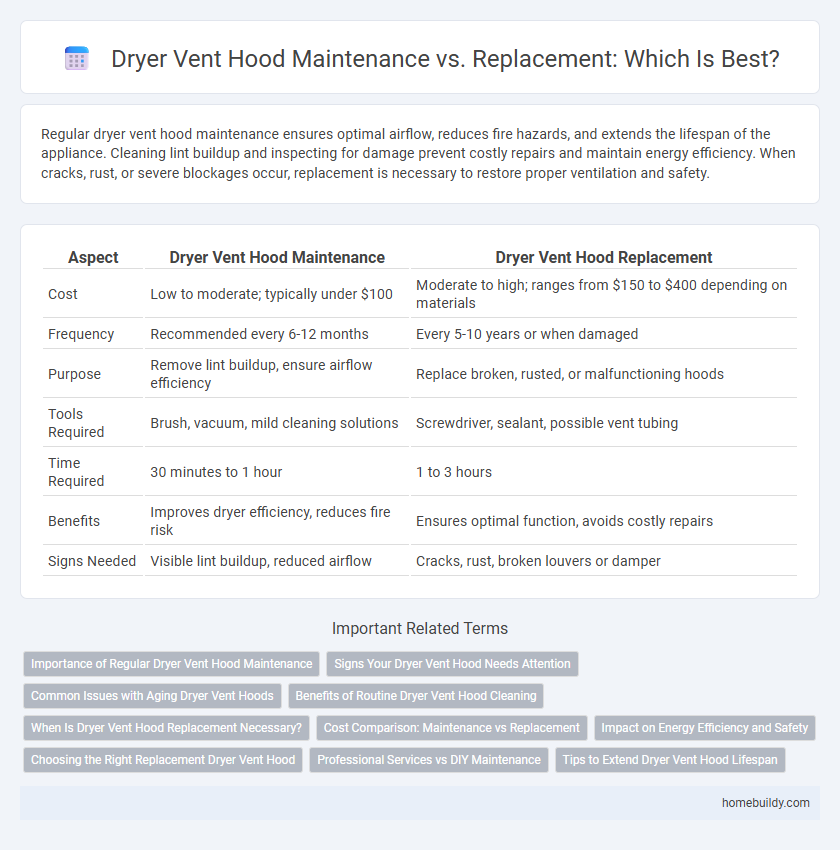Regular dryer vent hood maintenance ensures optimal airflow, reduces fire hazards, and extends the lifespan of the appliance. Cleaning lint buildup and inspecting for damage prevent costly repairs and maintain energy efficiency. When cracks, rust, or severe blockages occur, replacement is necessary to restore proper ventilation and safety.
Table of Comparison
| Aspect | Dryer Vent Hood Maintenance | Dryer Vent Hood Replacement |
|---|---|---|
| Cost | Low to moderate; typically under $100 | Moderate to high; ranges from $150 to $400 depending on materials |
| Frequency | Recommended every 6-12 months | Every 5-10 years or when damaged |
| Purpose | Remove lint buildup, ensure airflow efficiency | Replace broken, rusted, or malfunctioning hoods |
| Tools Required | Brush, vacuum, mild cleaning solutions | Screwdriver, sealant, possible vent tubing |
| Time Required | 30 minutes to 1 hour | 1 to 3 hours |
| Benefits | Improves dryer efficiency, reduces fire risk | Ensures optimal function, avoids costly repairs |
| Signs Needed | Visible lint buildup, reduced airflow | Cracks, rust, broken louvers or damper |
Importance of Regular Dryer Vent Hood Maintenance
Regular dryer vent hood maintenance is crucial for preventing lint buildup, which can lead to reduced efficiency and potential fire hazards. Inspecting and cleaning the vent hood every six months ensures optimal airflow and extends the lifespan of both the vent and the dryer. Neglecting maintenance increases the risk of costly repairs or the need for full replacement due to damage from clogged or corroded components.
Signs Your Dryer Vent Hood Needs Attention
A clogged or damaged dryer vent hood reduces airflow, causing longer drying times and increased energy consumption. Signs your dryer vent hood needs attention include visible lint buildup, unusual odors, and lint accumulation around the exterior vent. Regular inspection and cleaning prevent fire hazards and may indicate when replacement is necessary for optimal dryer performance.
Common Issues with Aging Dryer Vent Hoods
Aging dryer vent hoods often suffer from accumulated lint buildup, corrosion, and physical damage, which significantly reduce airflow efficiency and increase fire risks. Cracked or warped vent hoods compromise ventilation, leading to higher energy costs and potential moisture damage to the home exterior. Regular maintenance such as cleaning and inspection can extend the lifespan, but replacement becomes necessary when structural integrity is lost or persistent blockages occur.
Benefits of Routine Dryer Vent Hood Cleaning
Routine dryer vent hood cleaning improves airflow efficiency, reducing drying time and energy consumption while preventing overheating. Regular maintenance minimizes the risk of lint buildup, which can lead to costly repairs or fire hazards. Consistent cleaning extends the lifespan of the vent hood, ensuring optimal performance and safety.
When Is Dryer Vent Hood Replacement Necessary?
Dryer vent hood replacement is necessary when the vent is cracked, damaged, or severely clogged, compromising airflow and increasing fire hazards. Signs such as persistent lint buildup, pest infestation, or warped louvers indicate that maintenance alone cannot restore proper function. Regular inspection and timely replacement ensure optimal dryer efficiency and safety.
Cost Comparison: Maintenance vs Replacement
Regular maintenance of a dryer vent hood, including cleaning and minor repairs, typically costs between $50 and $150 annually, helping to prevent blockages and improve dryer efficiency. In contrast, replacing a damaged or outdated dryer vent hood can cost between $150 and $400, depending on materials and installation complexity. Investing in routine maintenance reduces the risk of costly replacements and enhances safety by preventing lint buildup and potential fire hazards.
Impact on Energy Efficiency and Safety
Regular maintenance of dryer vent hoods, including cleaning lint buildup and inspecting for damage, significantly improves energy efficiency by ensuring unobstructed airflow and reducing dryer run time. Conversely, replacing outdated or damaged vent hoods with modern, aerodynamic designs enhances safety by minimizing fire risks associated with lint accumulation and improving moisture expulsion. Proper maintenance and timely replacement both contribute to lowering energy consumption and preventing hazardous conditions in residential drying systems.
Choosing the Right Replacement Dryer Vent Hood
Selecting the right replacement dryer vent hood involves considering factors such as material durability, weather resistance, and vent compatibility to ensure optimal airflow and prevent lint buildup. Metal hoods with a built-in damper are preferred for their sturdiness and ability to block pests and debris effectively, contributing to improved dryer efficiency and safety. Proper sizing and installation alignment with existing ductwork reduce the risk of leaks and help maintain energy efficiency in dryer operation.
Professional Services vs DIY Maintenance
Professional dryer vent hood maintenance ensures thorough cleaning and inspection, reducing fire hazards and improving dryer efficiency through specialized tools and expertise. DIY maintenance may save costs but often lacks the precision needed to detect hidden blockages or damage, potentially leading to recurring issues. Replacing a dryer vent hood typically requires professional services to guarantee proper installation, compliance with safety standards, and optimal ventilation performance.
Tips to Extend Dryer Vent Hood Lifespan
Regular cleaning of the dryer vent hood prevents lint buildup, reducing fire hazards and improving airflow efficiency, which extends its lifespan. Inspecting the vent hood for damage or corrosion and repairing minor issues promptly helps avoid costly replacements. Using a quality vent hood cover also protects against weather elements and pest intrusion, ensuring long-term durability.
Dryer vent hood maintenance vs replacement Infographic

 homebuildy.com
homebuildy.com